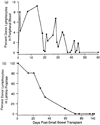Xenobiotics, chimerism and the induction of tolerance following organ transplantation
- PMID: 7584491
- PMCID: PMC2993237
Xenobiotics, chimerism and the induction of tolerance following organ transplantation
Abstract
The successful results seen after organ transplantation are largely attributable to the potency and specificity of modern immunosuppressive agents. Although drug-free unresponsiveness to graft alloantigens has not been routinely achieved in clinical practice, recent appreciation of the importance of cell chimerism, which develops after the migration from donor to host of leukocytes contained in solid organ grafts, has introduced a concept which may explain the mechanism of graft tolerance. Recent evidence has indicated that immunosuppressive drugs may have a common potential to induce graft tolerance, even though they act through diverse mechanisms, and that this potential may be mediated by a permissive effect on the migration and survival of donor-derived leukocytes. This review briefly examines the mechanisms by which immunosuppressive drugs function and analyses the different methods which these agents might use to induce chimerism associated with graft tolerance. Furthermore, we describe ongoing clinical studies in which the chimerism produced after solid organ transplantation is augmented with donor bone marrow in an attempt to facilitate the induction of tolerance.
Figures




Similar articles
-
Mixed chimerism achieved by a nonlethal conditioning regimen induces donor-specific tolerance to lung allografts.J Surg Res. 2008 May 15;146(2):289-97. doi: 10.1016/j.jss.2007.07.017. Epub 2007 Aug 23. J Surg Res. 2008. PMID: 18314139
-
Spontaneous and iatrogenically augmented leukocyte chimerism in organ transplant recipients.Transplant Proc. 1994 Oct;26(5):3071-6. Transplant Proc. 1994. PMID: 7940965 Free PMC article. Review. No abstract available.
-
Chimerism after whole organ transplantation: its relationship to graft rejection and tolerance induction.Curr Opin Nephrol Hypertens. 1994 Nov;3(6):589-95. doi: 10.1097/00041552-199411000-00005. Curr Opin Nephrol Hypertens. 1994. PMID: 7881981 Review.
-
Donor cell chimerism permitted by immunosuppressive drugs: a new view of organ transplantation.Immunol Today. 1993 Jun;14(6):326-32. doi: 10.1016/0167-5699(93)90054-o. Immunol Today. 1993. PMID: 8397774 Free PMC article. Review.
-
Donor cell chimerism permitted by immunosuppressive drugs: a new view of organ transplantation.Trends Pharmacol Sci. 1993 May;14(5):217-23. doi: 10.1016/0165-6147(93)90212-3. Trends Pharmacol Sci. 1993. PMID: 8212319 Review.
Cited by
-
Prevention of Transplant Rejection: Can Tolerance be Achieved with Immunosuppressive Treatment?Clin Immunother. 1996 Aug;6(2):89-96. doi: 10.1007/BF03259505. Clin Immunother. 1996. PMID: 21566684 Free PMC article.
References
Publication types
MeSH terms
Substances
Grants and funding
LinkOut - more resources
Full Text Sources
Other Literature Sources
